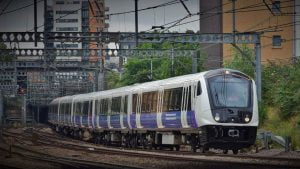This month marks 60 years since electric trains were introduced on the ex-London, Tilbury, and Southend line between Fenchurch Street and Shoeburyness.
To celebrate the anniversary, the current operator, c2c, ran a special offer during the COP26 conference to encourage more people to take the train, with 1,000 half-price off-peak tickets available.
The route’s first electric train ran on 7th November 1961, and by June 1962, all steam trains had been phased out.
Services on the Ockendon branch had been dieselised in 1958, but with the introduction of electric trains on the main line, electric trains soon replaced diesels on the branch.
c2c currently has a fleet of 80 electric trains which are more environmentally friendly than both their diesel and steam train predecessors, and provide a greener way of travelling.
For example, a passenger travelling from Southend to Fenchurch Street will reduce their CO2 emissions by 74% compared with driving in a diesel car.
Jeff Baker, c2c Engineering Director, said: “My predecessors from 60 years ago were ahead of their time when they invested in an electric fleet of trains for the rail line we now call c2c. World leaders are currently discussing environmental issues at the COP26 conference on a global level, but simple steps like taking an electric train instead of driving can help us all make a real difference to our own personal environmental footprint.”
Other energy-saving initiatives being implemented by c2c include fitting LEDs to all their station platforms and car parks, helping to reduce electricity consumption by 15%. By the end of this year, all external lighting will have been replaced by LEDs.
For more than a decade, all rubbish from station rubbish bins has been sorted for everything that can be recycled. Nothing is sent to landfill, as 85% of the rubbish collected is recycled and the rest is used to generate energy from waste.
For the past 15 years, over 25% of the energy used to power c2c’s trains has been generated through a technology called regenerative braking. That enables the trains to recycle their own waste energy to save electricity by capturing the energy that is created when a train brakes, converting back into electricity and feeding it back into the National Grid via the overhead power lines. That is a similar method to how many electric cars recharge their batteries when braking.
To reduce plastic use, the company is installing water bottle refill points, with the first one already having been installed at Grays. Thanks to c2c’s Community Fund, eight more will be installed during the next six months, with more to follow next year. It has been estimated that Londoners could save 175 plastic bottles every year by switching to refillable bottles.
Where Next on RailAdvent?
Subscribe for More
Railway News
DVDs, Prints, Cards, Gifts and more
MAINLINE STEAM INFO
Competition Time!
COMMUNITY PHOTOS
FREE NEWSLETTERS






Responses
One of their Class 357 units “357010” had the green livery with the purple doors going back 10 years ago because of regenerative braking system that have been fitted onto the entire Class 357 fleet.
And c2c have opted for 12 Class 720/6 Aventra 5-Car units to be manufactured by Alstom and are to be in service from mid next year which are to replace the Class 387/3 units. And possibly cascade the Class 387/3s to Great Northern, Gatwick Express or GWR as they are dual voltage units.